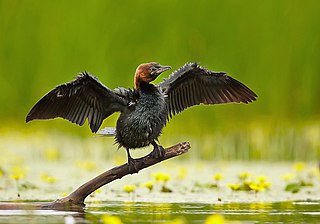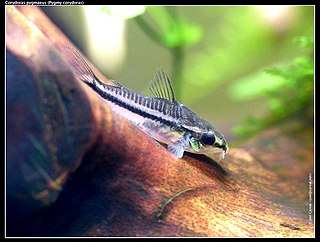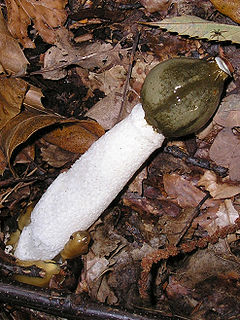
The pygmy cormorant is a member of the Phalacrocoracidae (cormorant) family of seabirds. It breeds in south-eastern Europe and south-western Asia. It is partially migratory, with northern populations wintering further south, mostly within its breeding range. It is a rare migrant to western Europe.

Phallus indusiatus, commonly called the bamboo fungus, bamboo pith, long net stinkhorn, crinoline stinkhorn or veiled lady, is a fungus in the family Phallaceae, or stinkhorns. It has a cosmopolitan distribution in tropical areas, and is found in southern Asia, Africa, the Americas, and Australia, where it grows in woodlands and gardens in rich soil and well-rotted woody material. The fruit body of the fungus is characterised by a conical to bell-shaped cap on a stalk and a delicate lacy "skirt", or indusium, that hangs from beneath the cap and reaches nearly to the ground. First described scientifically in 1798 by French botanist Étienne Pierre Ventenat, the species has often been referred to a separate genus Dictyophora along with other Phallus species featuring an indusium. P. indusiatus can be distinguished from other similar species by differences in distribution, size, color, and indusium length.

The pygmy corydoras or pygmy catfish is a tropical and freshwater fish belonging to the Corydoradinae sub-family of the Callichthyidae family. It originates in tropical inland waters in South America, and is found in the Madeira River basin in Brazil.

The soprano pipistrelle is a small bat that in taxonomy was only formally separated from the common pipistrelle in 1999. It is possible that these two groups diverged from one another in the Mediterranean and that is why the Pipistrellus pygmaeus has the ability to thermal regulate at such high temperatures as 40 degrees C.

Idiosepius pygmaeus, also known as the two-toned pygmy squid, is a species of bobtail squid native to the Indo-Pacific. It occurs in waters of the South China Sea, Japan, Philippines, Palau, Indonesia, Northern Mariana Islands, as well as northern and northeastern Australia. It inhabits shallow, inshore waters.

The genus Phallus, commonly known as stinkhorns, are a group of basidiomycetes which produce a phallic, often foul-scented, mushroom, from which their name is derived. The genus has a widespread distribution and, according to a 2008 estimate, contains 18 species. They belong to the family Phallaceae in the order Phallales. The best known species is the common stinkhorn.

The spotted piculet is a species of bird in the family Picidae. It is endemic to north-eastern Brazil.

The little ground squirrel or little souslik, is a species of rodent in the family Sciuridae. It is found mostly in Central Asia east to the Aral Sea.

The Philippine pygmy roundleaf bat, also called the Philippine pygmy leaf-nosed bat, is a species of bat in the family Hipposideridae. It is endemic to the Philippines, where it has been recorded on Bohol, Luzon, Marinduque, Negros, Panay, and Mindanao.

Phallus ravenelii, commonly known as Ravenel's stinkhorn, is a fungus found in eastern North America. Its mushrooms commonly grow in large clusters and are noted for their foul odor and phallic shape when mature. It is saprobic, and as such it is encountered in a wide variety of habitats rich in wood debris, from forests to mulched gardens or sawdust piles in urban areas. It appears from August to October. The fruit body emerges from a pink or lavender-colored egg to form a tall, cylindrical, hollow and spongy white stalk with a bell-shaped cap. The remains of the egg persist as a white to pink or lilac volva at the base of the stalk. The cap is covered in a foul-smelling olive-green spore slime, which attracts insects that help to spread the spores. Sometimes, the cap has a "veil" attached—a thin membrane that hangs underneath. The lack of a roughly ridged and pitted cap differentiates it from the closely related Phallus impudicus. The fungus is named after Henry William Ravenel, a botanist who first discovered it in 1846, though it remained undescribed until 1873. It is considered to be an edible mushroom while in its egg form.
Erigeron pygmaeus is a species of flowering plant in the daisy family known by the common name pygmy fleabane, or pygmy daisy.

Phallus duplicatus is a species of fungus in the stinkhorn family. The bell-shaped to oval cap is green-brown, the cylindrical stalk is white. When mature the cap becomes sticky with a slimy green coating that attracts flies that disperse its spores, and it has a distinct, "netted" universal veil. The fungus is edible when still in the "egg" stage, before the fruit body has expanded. It grows often in public lawns, and can also be found in meadows.

Phallus hadriani, commonly known as the dune stinkhorn, is a species of fungus in the Phallaceae (stinkhorn) family. It is a widely distributed species, and is native to Asia, Europe, and North America. In Australia, it is probably an introduced species. The stalk of the fruit body reaches up to 20 cm (7.9 in) tall by 4 cm (1.6 in) thick, and is spongy, fragile, and hollow. At the top of the stem is a ridged and pitted, thimble-like cap over which is spread olive-colored spore slime (gleba). Shortly after emerging, the gleba liquefies and releases a fetid odor that attracts insects, which help disperse the spores. Said to be edible in its immature egg-like stage, it typically grows in public lawns, yards and gardens, usually in sandy soils. Phallus hadriani may be distinguished from the similar P. impudicus by the presence of a pink or violet-colored volva at the base of the stem, and by differences in odor.

Phallus rubicundus is a species of fungus in the stinkhorn family. First described in 1811, it has a wide distribution in tropical regions. It has the typical stinkhorn structure consisting of a spongy stalk up to 15 cm (5.9 in) tall arising from a gelatinous "egg" up to 3 cm (1.2 in) in diameter. Atop the stalk is a pitted, conical cap that has a foul-smelling, gelatinous, green spore mass spread over it.

Leptosiphon pygmaeus is a species of flowering plant in the phlox family known by the common name pygmy linanthus.
Scyllarus pygmaeus is a species of slipper lobster that lives in shallow water in the Mediterranean Sea and eastern Atlantic Ocean. It grows to a length of 55 mm (2.2 in), which is too small for it to be fished for. The juvenile form was first described in 1885, with the description of the adult following in 1888 as a result of the Challenger expedition.

Phallus calongei is a species of stinkhorn mushroom. Found in Pakistan, it was described as new to science in 2009. Starting out as an "egg", the fully expanded fruit body consists of a single, thick, stipe with a cap attached to the apex and covered with olive-green, slimy spore-containing gleba. It is distinguished from other similar Phallus species by a combination of features, including a pinkish, reticulated (network-like) cap, and a stipe that is tapered at both ends. The edibility of the mushroom is unknown.
Phallus glutinolens is a species of fungus in the stinkhorn family. Found in Brazil, it was described as new to science in 1895 by Friedrich Alfred Gustav Jobst Möller as Ithyphallus glutinolens, and later transferred to the genus Phallus in 1898. The species was emended in 2009.
Anisocanthon pygmaeus is a species of true dung beetle that is found in Entre Ríos, Santa Fe and Buenos Aires Provinces in Argentina, and is believed to also be found in Rio Grande do Sul in Brazil. It has not been recorded in the last 60 years.

















